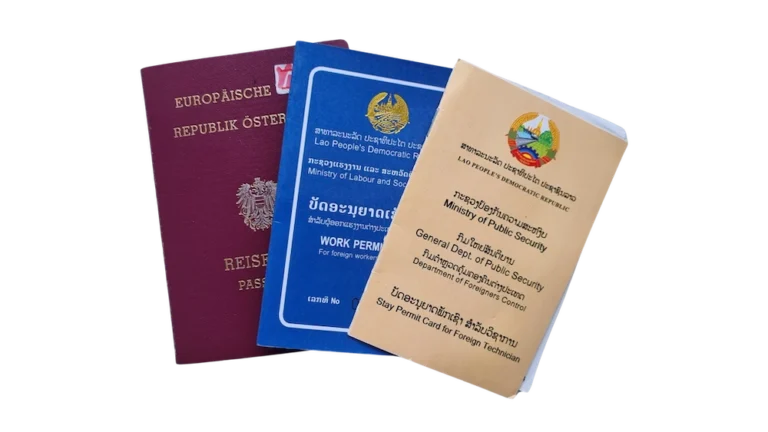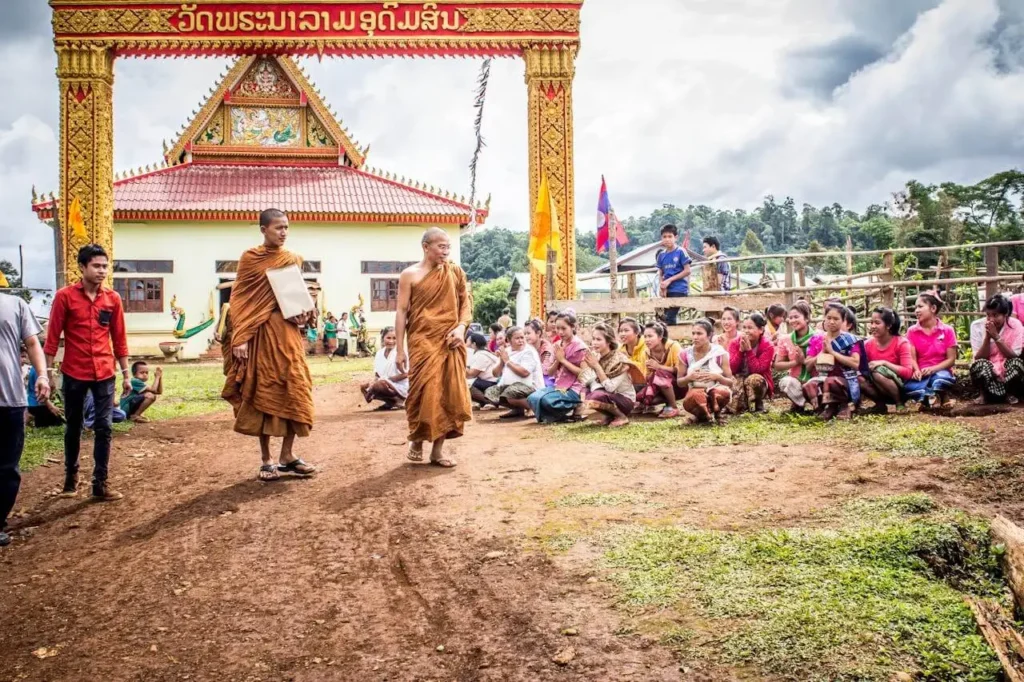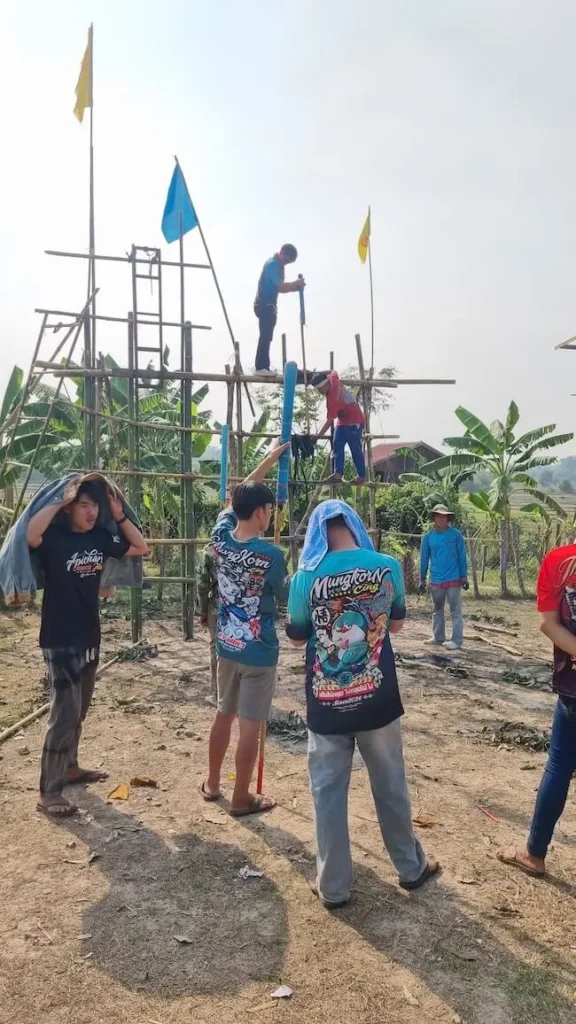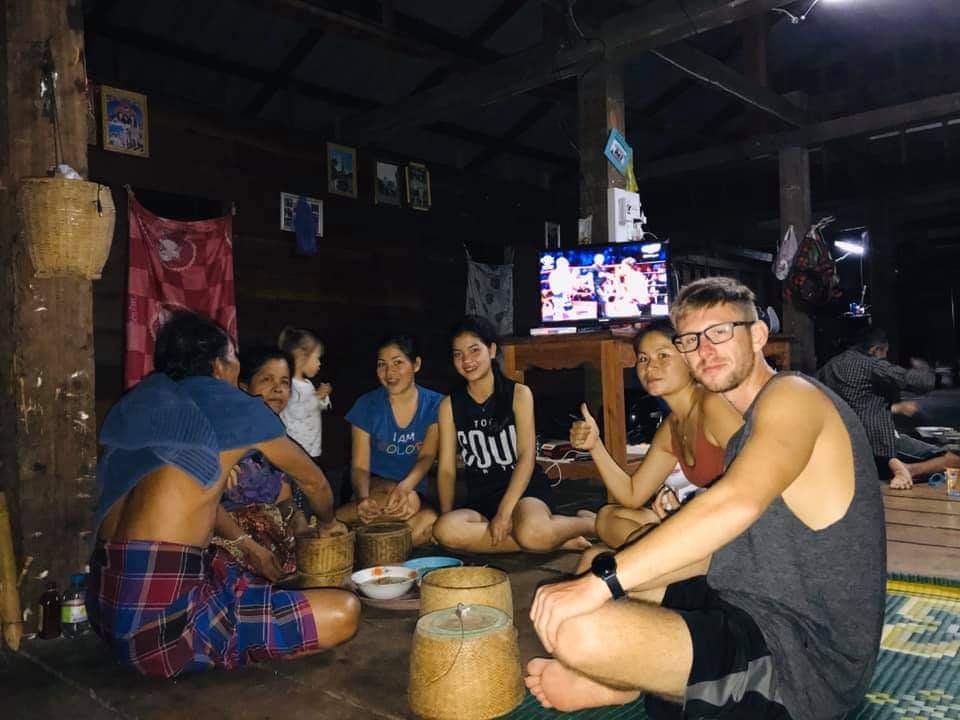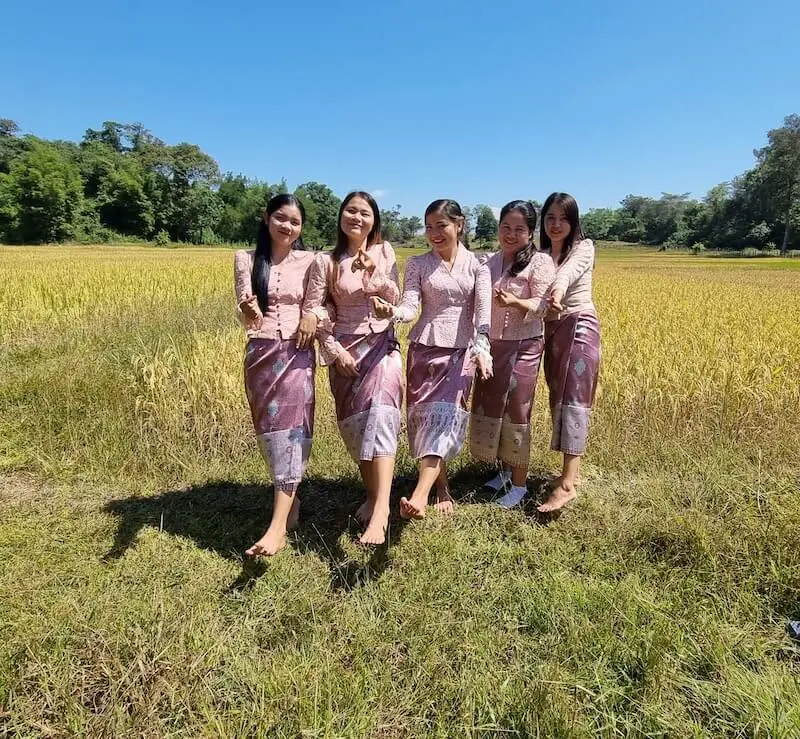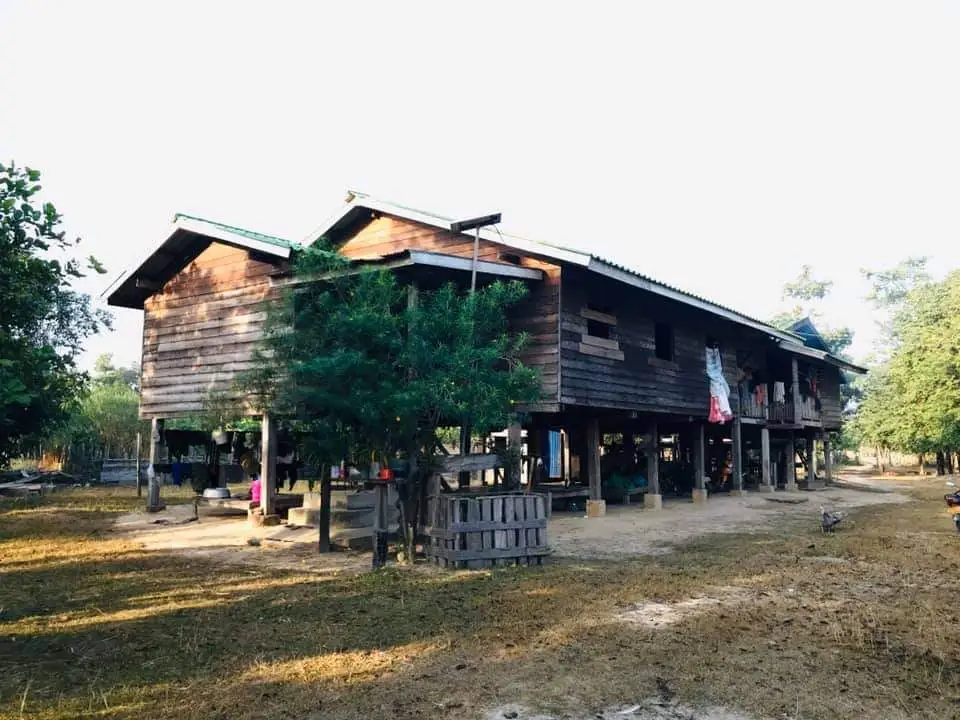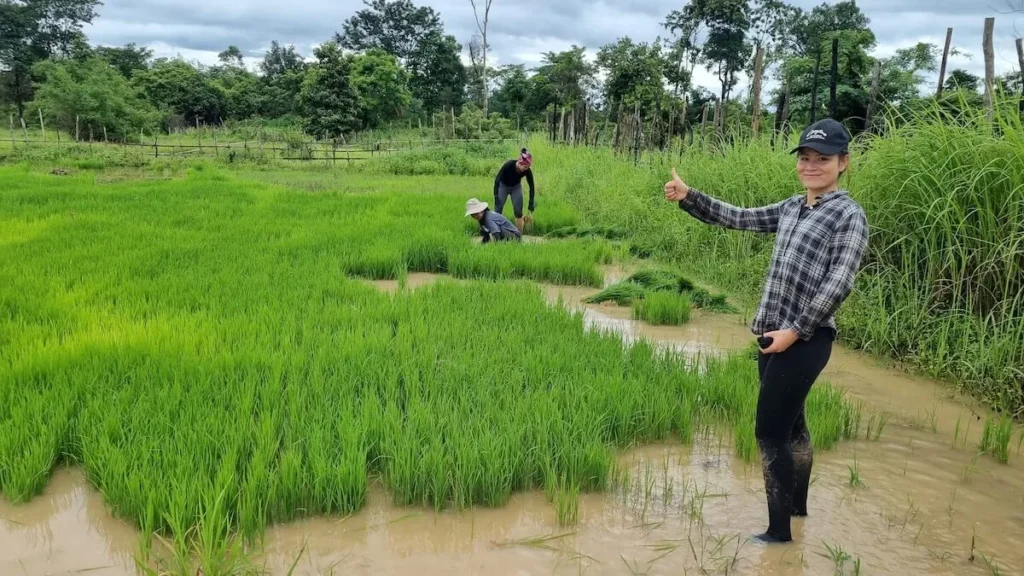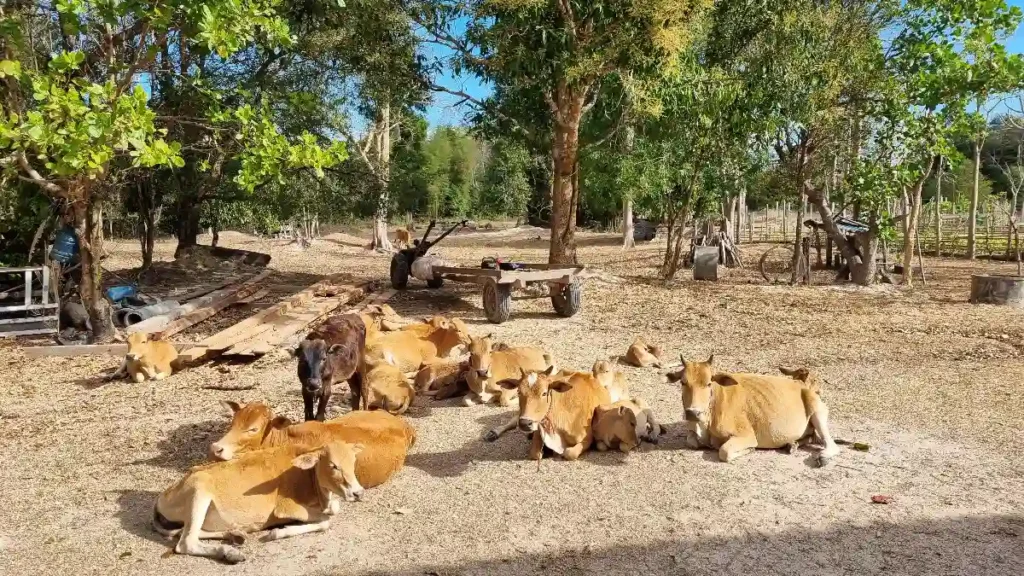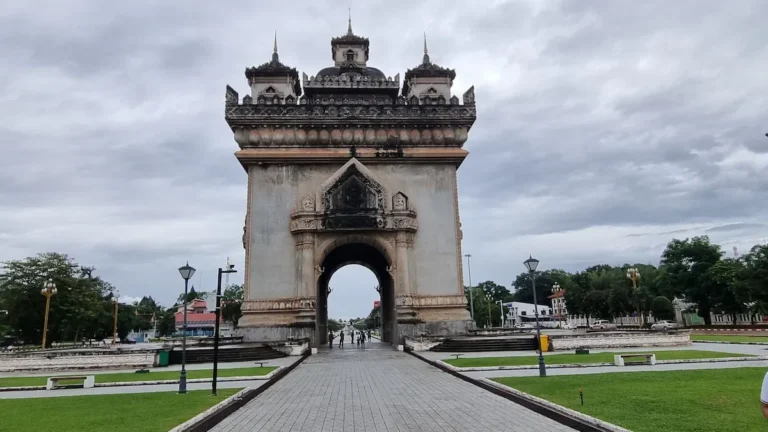Traditional Lao Clothing as cultural Identity
Traditional Lao clothing is more than just fabric—it’s a living symbol of cultural identity and pride. The most iconic garment is the “sinh,” a handwoven skirt worn by Lao women, often made of silk or cotton and patterned with motifs that represent regional origins. Men traditionally wear the salong, wide-legged trousers, or the phaa biang (shoulder sash) for ceremonial occasions. These clothes are still commonly worn during festivals, temple visits, and family events, showing that Lao people remain deeply connected to their roots. In a country with over 49 ethnic groups (over 160 sub-groups), clothing is also a way to express ethnic heritage, with each group weaving distinct styles and patterns. Wearing traditional attire isn’t about nostalgia—it’s about keeping Lao culture visible, proud and alive in everyday life.
For Lao weddings, official festivals or funerals it is an unwritten dresscode to show up in traditional lao style clothes. Even government officials and office workers are wearing either uniforms or the traditional “sinh” for women. If you’re visiting an official government office, it is expected for women to wear traditional clothes and men should wear at least some trousers instead of shorts. Laos is an old-fashioned & traditional country – respect that when being invited somewhere or visiting government buildings.
Lao Weddings: A Blend of Tradition and Spirituality
Lao weddings are deeply meaningful events that blend Buddhist beliefs with ancient animist customs, centered around family, community, and spiritual harmony. The heart of the ceremony is the Baci ritual, where elders tie white cotton strings around the couple’s wrists to call back the 32 guardian spirits (kwan) for blessings, health, and unity. Weddings are often held at home, with family and neighbors preparing food, decorating the house, and playing traditional music. The bride typically wears a beautifully woven sinh, while the groom dons traditional Lao attire. More than just a legal union, a Lao wedding is a celebration of respect, connection, and shared values, where both families come together to honor love, ancestry, and social bonds.
Lao weddings are absolute fun, so if you are ever invited, do not hesitate to go! The couple usually hands out official invitation cards with your name on it. You have to bring this card to the wedding day and put some money inside. The amount depends on the relationship with you and the couple. Do not bring physical presents – this is not common at all. Only cash is King! But once you are getting married and invite that couple, the money will be returned because they will exactly remember how much each guest put inside the envelope.
In Laos it is still common for the men to pay a dowry. Even some sources in the internet say it is not wide-spread anymore – it definitely is. It is expected for the groom to pay an amount of cash to the parents, often combined with some gold. The dowry is usually set by the parents and also by social status. So if both, groom and bride come from middle-class or richer families, the price for the bride will be higher. While families from rural villages, will agree on a much lower price. The money will be openly presented to the guests who are attending the ceremony, that everyone can be witness of the dowry being paid. And of course it is also village gossip how much was being paid. Nowadays it is common though, that the dowry or part of it is given back to the couple as a start into their life together as a married couple.
Foreigners dating Laotians - is it legal?
Many foreigners who live in Laos or have spent extended time there have probably heard about a fine being set by the police if an unmarried foreigner–Lao couple lives together. And this is actually true – well, it’s partly true. There is a law that forbids unmarried couples from sleeping together and it was originally introduced to protect Laotian citizens, especially women, from being trafficked or exploited, particularly across borders to countries like China. However, it’s important to note that this law is quite old and in practice, enforcement is often inconsistent. In remote villages, local or district police may still ask for marriage or engagement papers and in some cases, a small “informal payment” may be expected to smooth things over if you are not officially married yet. In contrast, in larger cities like Vientiane, Luang Prabang or Savannakhet, it’s uncommon for authorities to interfere and many mixed couples live together without issue—especially if they maintain a low profile and show respect for local customs. But is is possible!
The process for foreigners of getting officially married in Laos is quite a long process and can be costly. Both sides of the couple need to prepare a lot of documents, translate them into lao language and then get approval from all authority levels in Laos: Village Chief (Nai Ban), District Police, Provincial Police, Ministry of Foreign Affairs. This process is long and many couples choose an agency to get the paperwork done for them. The costs can vary from 2.000 USD – 3500 USD. So make sure you really want to marry your Laotian partner and have good intentions!
The Lao Language: Rooted in History, Spoken Across Borders
The Lao language (ພາສາລາວ) is the official language of Laos and a cornerstone of its national identity and Lao Culture. It belongs to the Tai-Kadai language family, which is believed to have originated in southern China. Over centuries, Tai-speaking people migrated to the South, interacting with Mon and Khmer civilizations, which influenced Lao vocabulary, writing systems and religious terminology. In particular during and after the Khmer Empire period. The modern Lao script itself is derived from the Old Khmer script, which shaped how the language is written today.
Laos is home to a rich tapestry of over 160 ethnic groups, each contributing to the nation’s linguistic diversity. Beyond the Lao language, numerous other languages are spoken, including Hmong, Khmu, Akha, Lue, and Lahu, among others. These languages belong to various language families such as Hmong-Mien, Austroasiatic, and Sino-Tibetan, reflecting the country’s complex ethnic mosaic.
This linguistic diversity is not just a testament to Laos’s multicultural heritage but also plays a vital role in preserving the unique identities and traditions of its many communities. Efforts to document and promote these languages are crucial for maintaining the nation’s rich cultural fabric.
Lao Language & Northeast Thai Language (Isaan) - Same Same?
A significant aspect of Lao linguistic heritage is its close relationship with the language spoken in the Northeast of Thailand, known as Isaan. While often referred to as a separate dialect, Isaan is essentially a variant of the Lao language. The term “Isaan” denotes the region rather than a distinct language. Historically, this area was part of the Lao kingdom of Lan Xang before becoming integrated into Siam (now Thailand) in the late 19th century. As a result, the Lao language persisted in the region, albeit written in the Thai script and influenced by Thai vocabulary and pronunciation.
However, during the 20th century, the Thai government implemented a policy of “Thaification,” aimed at assimilating ethnic minorities – including Lao-speaking people into a singular Thai identity. This included promoting Central Thai language in schools and discouraging the use of Lao in public life, leading to a gradual erosion of cultural identity in the region by calling it Isaan instead of Lao. Until nowadays the whole Northeastern Region of Thailand still informally speaks Lao-Language. In fact, there are more speakers of the Lao Language nowadays than in Laos itself (15-20 mil.). Because so many Laotians migrated to Thailand during wars, most of the Isaan-Thai people have Lao origin. They even refer their unofficial Language as Lao Language and as someone who can speak Lao I can confirm that Isaan Thais speak the almost exact same language as in Laos, with very small differences mixing Standard-Thai into it. So we can sum it up as Isaan Dialect = Lao Language
Lao Music and Dance: The Heartbeat of Tradition & Culture of Laos
Lao music and dance are vital expressions of cultural identity, passed down through generations as a way to celebrate life and honor their ancestors. At the core of traditional Lao music is the “khene“, a bamboo mouth organ and national instrument of Laos, known for its haunting, melodic sound. It often accompanies folk songs and dances, especially during festivals, weddings, and temple ceremonies.
One of the most iconic dance forms is the “fon”, a graceful and symbolic style performed by women wearing traditional sinh skirts, often telling stories through slow, flowing hand and arm movements. Each region has its own variations of music and dance, from energetic Lam Saravane folk tunes in the south to more ceremonial and court-style dances in Luang Prabang. These art forms are not only entertainment, they are a living memory of the Lao people’s spiritual life and agricultural rhythm. Many lao songs are about love, family, food or agriculture.
Lao housing and Village Life
Traditional Lao homes are typically built on wooden stilts, a practical design that protects against flooding, allows ventilation and provides space underneath for storage or simply to hang out on hot days. These wooden stilt houses are especially common in rural areas, where materials like bamboo and other wood are locally sourced. In Laos you can still see mostly local style houses, where people live because around 65% of Laotians live in rural areas. Laos is also not a very densely populated country.
In contrast, modern homes in urban areas are increasingly built with concrete and bricks, often losing the open-air charm and community-centered layout of traditional houses. Despite the shift in building style, the sense of community remains strong—in villages, neighbors often cook together, share tools, and gather in communal spaces. Lao village life is rooted in cooperation, respect for elders, and shared responsibility, making the home not just a private space, but part of a larger social structure. Laotians would invite you anytime for food or drinks. It is very common to sit down, chat and have a meal together.
Importance of the Cultivation of Sticky Rice
In rural Laos, daily life is deeply connected to the cycle of rice cultivation, especially the growing of sticky rice (khao niao), which is both a staple food and a symbol of identity. For most farming families, rice isn’t grown for sale, but rather for self-sufficiency – harvested once a year and stored in traditional rice granaries to feed the household throughout the year. The work is done collectively, often involving the entire family and neighbors, from planting in flooded paddies to harvesting by hand. This rhythm of life reflects the close relationship between people, land and community. Sticky rice is not just food—it’s a daily ritual, eaten with every meal and always shared, reinforcing the values of togetherness and simplicity in Lao culture.
Usually rice can be grown only once per year at the beginning of raining season. But in some areas, villagers have collectively set up a water reservoir, which makes it possible to flood surrounding rice paddies and grow the beloved sticky rice twice per year. It is still a very labour intense process, but Laotians would never give up eating sticky rice. Same as Europeans love potatoes as a stable in their meals.
